Review GSM phone Sagem myX6-2
Package:
- Handset
- Battery
- Manual
- Charger
- CD с программным обеспечение
- Stereo headset
By the release of its X8 the company of Sagem attracted wide attention on the market for the first time. With comparatively low price the phone is equipped with a relatively good function kit, perfect screen, and it seems the maximum of today functions. "Paper" specs of the model are perfect, the real ones are not as good, and however for its price category the handset has no rivals. Following plain logic, we could suppose two directions for development - the first one involves launching cheaper models with a slight difference from the elder one, and the second, in its turn, growing technical specs of the flagman and adding new capabilities. The first direction revealed fast and represents Sagem myX6-2.
Technologically from the myX-8 it differs in no way, inside they are equal. At the same time, from the marketing point of view, the myX6-2 and myX-8 should stand separately on the market. The marketing specialists used rather an old solution; they changed the design of the younger model which quite fits the Sagem style, at the same the elder one was worked out by a designer studio Ora-Ito. So, the appearances naturally differ now, if the X8 is unordinary and has stylish traits, the myX6-2 is very standard, even more. At the same time both models have similar dimensions and weight the same (110x47x19 mm, 104 g).

The myX6-2 is assembled well; no backlash appears between the parts. The panels (both front and back) are interchangeable, which means theoretically a possibility to choose them to your liking. In practice, you will fail finding accessories outside France for Sagem at all.

Standard colour solutions are monochrome and are very bright. Fingerprints stay on the lacquered panel covering; however, they are seen not as much. Decorative elements like a navi button, a camera gap on the back surface and a loudspeaker grate are on a good level. They are nice and attract attention. This model takes an intermediate position having parted from the Sagem's design. However, it has not reached the level of a finished product with all the elements bound into a general essence.

The screen is a strength, which resolution forms 176x220 pixels. Up to 9 text lines feature the screen, the fonts are scalable (in a text entering mode it requires one touch). Working with the screen is pleasant due to the brightness and sharpness of the picture. In contrast to the X8 where the screen is the same, here the brightness is reduced artificially. The reason can be found in the same marketing, and then comparing the two models will show the supremacy of the leading model in the screen quality. Higher brightness made the image worse distinguishable in the sun. This disadvantage is not as evident here, however, still is present.

As for the picture quality the model is not the best on the market, Motorola's (Sharp matrix), Sharp, Panasonic's (the last clamshell line) phones compete with it. Losing in the picture brightness, they still are leading due to the colour play, smoothly shown sharp areas, more natural graphics. I'd like to compare Asian and European TV sets as an example. The first case provides really striking colours, and the second case shows pale, the maximum close to the reality. Both TV sets have the same screen capabilities, and the colour rendering is only a matter of the current settings. After buying Asian devices, many people select other colour profiles closer to the outside colours. This example shows different in perception the environment, and can be referred to Sagem myX6-2. This device attempts to shock a customer with an external gorgeousness. The way is right and proved. Here the screen is one of the bets, which is an advantage as well.
The keypad layout is terrace like; the buttons are large and comfortable. Despite the dimensions and the weight of the device are not optimal for entering data with one hand for long, the phone is comfortable to work with. The key backlighting is white and the brightest in the first and the third horizontal rows. In various conditions the characters are seen well. The navi button deserves mentioning. It is 4D with an OK one centered. The button is well styled, and the handset features automatic keylock.



A coupled volume button features the left side surface. A camera button is a bit lower. IrDA features the opposite side. And an interface connector copies the X8's one being placed on the bottom end.



A 1.3 MP camera objective is placed on the back side, and a mirror is here as well. The flash is absent in this model.

One latch is used for the fastening, which is a familiar construction used in the previous models. To access a microSD slot, you'll have to remove the back panel and then turn up the front one, or remove it completely. Formally, the device supports hot card change; however, in such a way it can't be called hot due to many actions necessary. The microSD (aka TransFlash) format becomes standard for mobile phones, and that's why the company turned to microSD, which is one more significant difference form the myX-8.


A 760 mAh battery is used in the phone. According to the maker, it is capable of about 200 hours of standby time and up to 3 hours of talk one. In Moscow the phone worked for about 4 days in case of 60 minutes if talks and 20 minutes of using other functions. With Bluetooth constantly on the device worked for about 2 days in case of the same talk time. Using the MP3 player dramatically decreases the charge (the screen backlighting on), the device lasts for a day (3 hours of music, 30 minutes of talks, Bluetooth on). Full recharging takes about 2 hours or a little less.

Menu
The main menu is represented only in one view. That is a 3x4 matrix, and fast navigation using number sequences works. Submenus are vertical lists, and by the way, unlike other company models, they refused a large icon and tips for it. The new representation shows titles of the items in a vertical list and a small icon nearby. The menu loses no brilliance, but just gets more ergonomic (you need no scrolling the menu any more searching for a necessary item, you see them all in front of you).

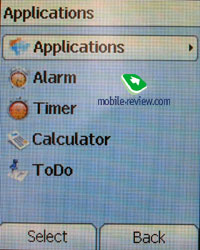

Both soft keys can have fast call tags, which are selected from the settings.
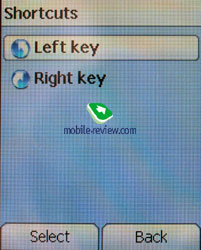

The menu is localized very badly, some terms are translated incorrectly, and you can't understand what the developers meant instinctively. And unfortunately, there are many mistakes in words. The localization is carried out in that way the items are not conformed. These many points allow saying the localization is carried out carelessly.
In the menu while entering text (messages, phonebook) you can select Russian both for letter by letter input and T9 dictionary. However, this action doesn't switch the layout, so you keep on entering in English. Russian input is available if turning the interface to English and then setting Russian for T9 (no letter by letter input).
A bank of memory forming 10 MB is available to a user.
Phonebook. The general list represents either names from the internal memory or names from the SIM memory. Copying names from one medium to another is supplied. Contacts are also typical for the company of Sagem.

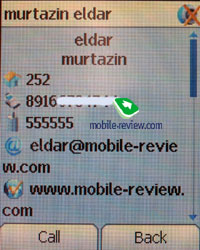
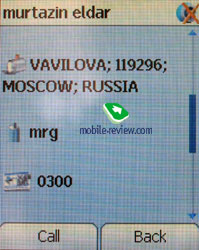


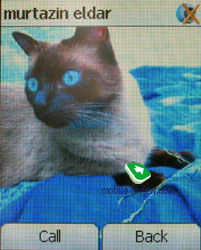
All actions of entries can be taken by choosing a necessary icon or selecting the menu of the phone book - this is the first item and placed over the first backlight entry. Each entry can feature a big amount of information: Name, Surname, and Notes (this is not a common thing for modern devices). You are free to add three more phone numbers (one for stationary), Company's name, e-mail, photo and a melody assigned.
It is important to follow the correct input of phone numbers, because if you insert a work or home phone number in the cellular phone's slot, you will not be able to send an SMS. When you are viewing an entry - the first number is that you have entered the first, it becomes a default one. The menu with numbers scrolling is possible by pressing the Call button and so you can select a necessary one. On the whole, the phone book is rather unusual, but not hard to get used to it and feel comfortably.
No users' groups are present, though you can make mailing lists for a group SMS and MMS.
Messages. You may create personal templates in the main memory and a necessary number of them. The device supports MMS, besides usual SMS and EMS standard. The function was tested in several networks and showed its working capability. A possibility to create MMS containing several pages (slides) is a real advantage; similar organization is to be found in the Sony Ericsson devices. Predictive text input T9 may be used as well.
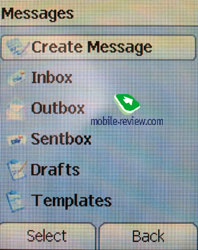
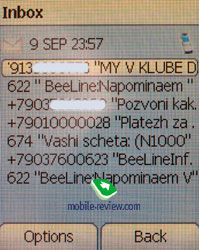
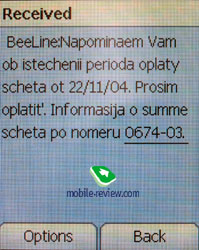
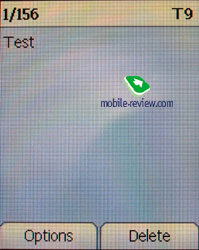
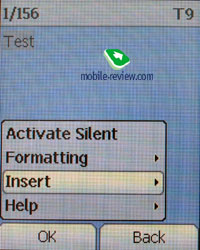
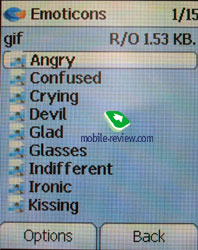
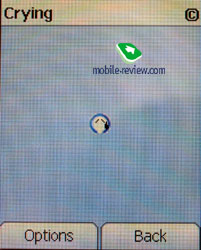

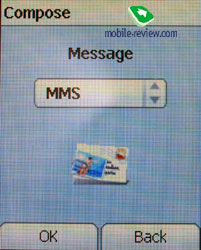
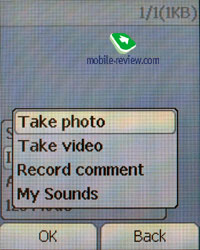
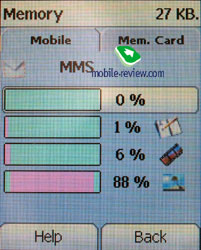
Organizer. Various events, a reminder for them may be entered and also you may set date and time. Calendar view is possible for a month, a week with a time scale and for a day.
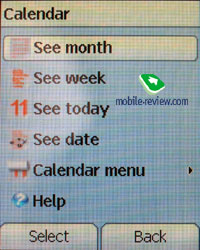
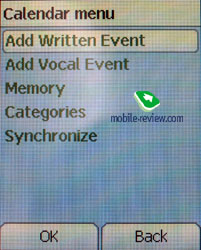
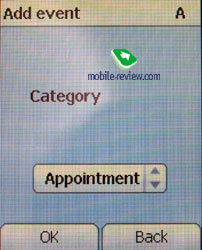
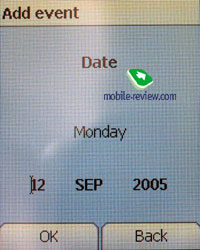
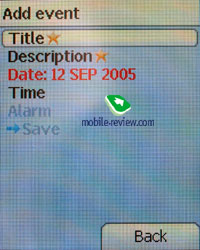
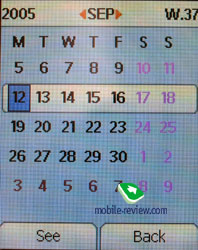
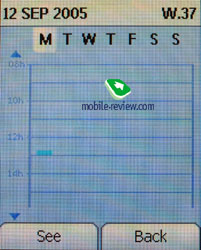
Settings. Sound. This menu holds melodies for a call, an incoming SMS message, MMS, a fax, and an alarm clock. You select items from the general list including uploaded MP3 files. The phone allows setting not just a mixed signal type (vibra and a melody at the same time) but also put the order of vibra working first and then after a melody is played. A dictaphone recording may serve as a call alert (duration up to 30 seconds). It is significant that such recording starting from the settings menu, but not from the dictaphone.


Screen. The choice of colours is limited with thee variants. Any graphic file can serve as a wallpaper and a screensaver. The energy saving mode permits to indicate whether a backlighting of the screen and the keypad needs at the same time.



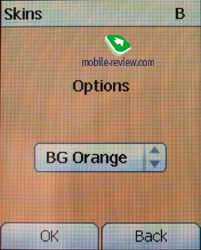
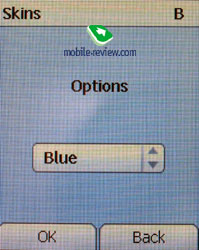
Calls. Here you will find settings of redirection, a black list of numbers, timers.
Security. You may select an automatic keypad locking; secure such functions as call list, messages, organizer with a password. The security is adjusted separately for a single item.
Tags. A function of a quick call is adjusted for the left and fight softkeys.
Type of file representation. A file can be shown as a matrix or a list. In the former case, when you are viewing photos or videos, you see small images, in the latter case, you see only titles in a vertical list.
WAP settings. Everything is traditional and there is a possibility of using GPRS. If you are not about using it at all, I advise to take it off the menu.
The camera settings are accessible here merely - they are unable to call when recording. It is the first time they are integrated into the shooting menu, which is much more convenient for changing settings on the fly.
Connectivity. The device supports data communications with the help of an IrDA, a Bluetooth. There is a separate setting for the car kit and that is nice (volume level, answer mode). Standard SyncML is also supported.
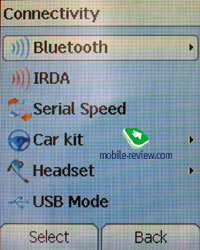

The handset completely supports both an IrDA and a Bluetooth and so you can transmit photos, pictures, music both from and to the device. Uploading new Java applications is supported only using wap, for uploading them from a PC is fundamentally lacking.
The handset supports the following Bluetooth profiles:
- DUN-GW
- Fax-GW
- GAP
- Generic Object Exchange
- HandsFree-AG
- Headset-AG
- OBEX
- OPP-Client
- OPP-Server
- Serial-DevA
- Serial-DevB
The lack of a possibility of direct working with the device's memory from another handset or a PC as it is done in Sony Ericsson phones looks not so good. The next drawback of the device without specialized software is an impossibility of sending several files at once.
A service with headsets makes no troubles and the device is reliable. The phone was tested with the headsets Sony Ericsson and Jabra. There are several little shortcomings worth mentioning: while sending files to a PC it does not always works stably. Also I'd like to mention with Bluetooth on battery life shortens for 35-50 percents.
Bluetooth realization is peculiar in that the device is seen only in the course or 3 minutes, and then you have to confirm you want it seen. This is made due to security means, and may have grounds.
Multimedia. Here you can view the amount of spare memory and its distribution between various applications. There is also an access to videos, pictures and sounds. An automatic playing a selected record in a small window is a nice advantage when viewing the video folder. A video is played in a large window with some widgets and not fullscreen.


A special tag is present in all the menus where the memory card s accessible. At the same time data from these sources is not viewable. You can upload any files to the card and from it. Working with the memory card from a PC is almost unrealized, so disassembling the phone is necessary. On the other hand, you can select the place to save your data received via Bluetooth or IrDA, and that is when the card can be used. But then you'll have to humble the speed is low (much losing to an exterior card reader).
Applications. Alarm clock is single, there is Snooze function.
Countdown timer is customary.
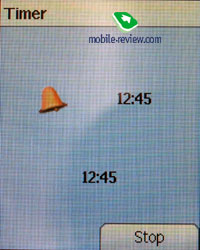
To-do list permits to enter notes in several categories and view them in the general list. Besides typed tasks, you can insert voice notes.
Calculator, currency converter is rather simple.
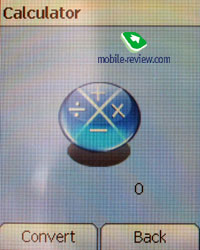
Applets is the menu where you save your uploaded applications.
WAP. The handset has OpenWave preinstalled and the settings are quite flexible. A pleasant surprise is you can arrange download, and leave the browser.
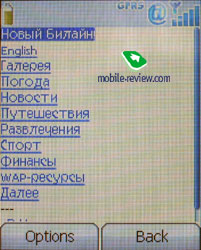

Camera. The screen serves as a viewfinder. When you are recording, movements of the joystick activate a digital 8x zoom. Various values of the zoom changes very smoothly, the animation is pleasant. Left deviations of the joystick change the settings of illumination. The device stores the latest selected value. There is about a dozen of settings and so a switch is not quickly done. Right deviation of the joystick engages one of three effects - negative, sepia, a black-and-white photo. The following photo resolutions are available - 1280x1024, 1280x960, 800x600, 640x480, 320x240.

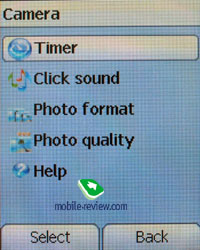
Sagem myX6-2
|
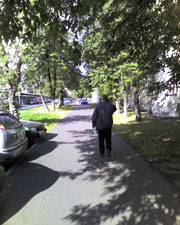 |
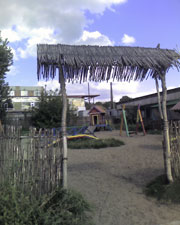 |
(+)
increase, 1024x1280, JPEG |
(+)
increase, 1024x1280, JPEG |
 |
 |
(+)
increase, 1024x1280, JPEG |
(+)
increase, 1024x1280, JPEG |
 |
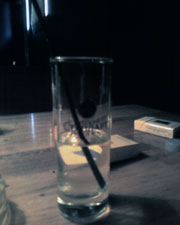 |
(+)
increase, 1024x1280, JPEG |
(+)
increase, 1024x1280, JPEG |
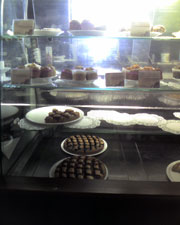 |
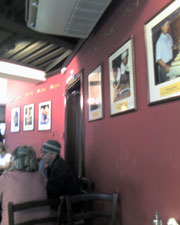 |
(+)
increase, 1024x1280, JPEG |
(+)
increase, 1024x1280, JPEG |
 |
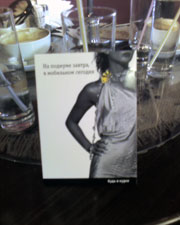 |
(+)
increase, 1024x1280, JPEG |
(+)
increase, 1024x1280, JPEG |
The camera quality is middling, it loses to the X8, though, it may be caused by the software available, since the modules are equal. A photo in the max resolution and quality is saved for 5-6 seconds.
Video. In contrast to the camera, there are no settings to adjust (only the sound can be off while recording), the zoom is not availed. The record quality is middling.
Video sample (725 KB)
Productivity. JBenchmark. As different to the myX-8 the second version of the test package Jbenchmark worked here, however, a 3D package refused working. Of Java applications, wap-connection with results loaded didn't work, we tested it (the device writes the profiles is not installed, though it really is present, and then the connection starts, this is the condition the phone can stay forever). The results of the first version of the package are the following:
|
myX6-2 |
myX8 |
| JBenchmark 1 |
1576 |
1182 |
Details |
| Text |
503 |
437 |
| 2D Shapes |
374 |
128 |
| 3D Shapes |
163 |
32 |
| Fill Rate |
48 |
10 |
| Animation |
488 |
575 |
The second version of the package provided the following results:
|
myX6-2 |
| Jbenchmark 2 |
41 |
Details |
| Image manipulation |
28 |
| Text |
83 |
| Sprites |
60 |
| 3d Transform |
7 |
| User Interface |
110 |
We can say the productivity of the Java machine is usual for this class. Unfortunately, the problems with compatibility still remain, not all the third party applications are runable (mainly that concerns applications based on MIDP 2.0).
Games. The handset has the only preinstalled game - Bubble Trouble. You have to collect falling balls into a glass (a variant of Tetris).
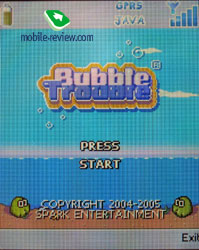

Audio player. It has few abilities. There is a possibility of creating playlists and switching between compositions. Still an equalizer and a repeat function are lacking, as well as the others excluding random playback. The handset's memory or a memory card can serve as a source (any folder, not only Music). MP3 files are supported as well as ACC ones.
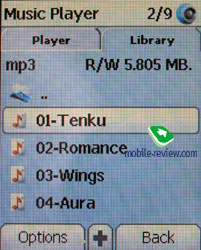

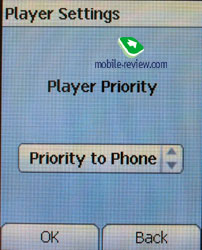
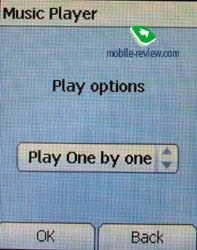
In the player settings you can set One by One or Continuous playback. The first case plays one melody and stops before the second, to make it play further; you need to press a key. The second case allows playing back all the melodies in the specified folder or play list. I do not quite understand why it was made.
At an incoming call, the melody is interrupted, and having finished the conversation, you can start it from the same place (the play back doesn't start automatically). However, there is an item in the settings which allows selecting the priority for the mode - either a phone mode or a player. Theoretically, the player priority means the player keeps on playing at an incoming call. Practically, nothing changes if selecting any of the items; it influences the device in no way.
The player minuses include the fact it doesn't play in the background mode, even keylock is not available. Moreover, the screen is backlight in the minimal level, which tells on the battery (and listening to the player for a day will dramatically discharge the battery).
The sound quality in standard earphones rouses no cavils, however, at low bit rate low frequencies disappear (that is exactly the problem of the headphones). Though, these earphones are quite enough for listening to pop music. Due to the original interface connector, no third party headphones can be used, which is a minus. Finding the same headset model as included into the package seems impossible, and service centers still have no samples either.
Synchronization with PC. The program is not very fast, sows down sometimes (and then response time reaches several minutes). Advantages include a capability to edit the phonebook on a PC, entering SMS, working with photos, video (only using this software you can upload all the photos to a PC at one stroke, sending from the phone allow only one file at a time unit). Direct synchronization with MS Outlook concerns a calendar, contacts and to do list. SyncML is used for synchronization, at the same time the device understands Russian entries in no way (all the titles turn into nonsense). No other evident disadvantages of the program are observed.






Impressions
The device provides connection quality quite comparable to modern phones, the advantage is a loudspeaker volume during a call, it is enough, the sound is pure. The call alert is 64-tones polyphonic, and a set of modern well-sounding melodies is provided. Additionally, various animal languages are present. You can use mp3 or AAC file as a call melody, which makes setting the device to your liking a plain action. The power of a vibracall is average, tinkle is little, and you can either feel it or not. And mainly sensitivity to the vibracall depends on a person.
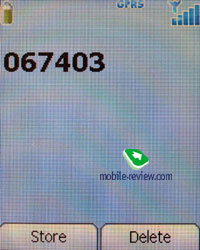
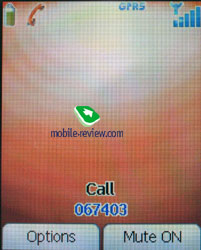


The call list available by pressing a call button consists of 20 entries. A type of the call, its time are shown, an icon of the type (incoming, outgoing) is not very clear because the arrow is placed either to the left of the handset or to the right, which confuses a lot. The same numbers are not summed up and are shown one after one.
The changes as compared with the myX-8 are not very significant, though noticeable:
- Lower screen resolution, brightness, higher readability in the sun (though physically the screens are equal)
- CMOS camera module instead of CCD, lower photo quality
- microSD memory slot instead of SD
- The software is worked out and new player functions appeared
Unfortunately, the model had no time to absorb all the software changes, that the predecessor longed for. It seems the device was launched in such a hurry that many functions were not developed. And considering the same situation with the X8, which is unsolved today either, we can speak about a total rawness of the solution through the whole its life circle. And let alone wap-browser instability which causes restart of the device. And another "pleasant" moment is you start loading a JAD-file normally, and then the device alerts a mistake. Loading the same JAR-file causes no problems (however, you can call a Game or Applications folder, but an application will be installed where you saved in for the first time).
Now the model costs about 215-230 USD, which makes it attractive for those who can put up with no normal localization, many wap problems, unstable work. The handset is ideal for young men limited in funds but wishing all the modern capabilities, though not carrying about the realization. I'd like to repeat the "paper" specs are interesting; however the realization is not as attractive.
The rivals are Siemens CX75, Alcatel S853 (however, this one has not been released, and it's
uncertain when it will), Motorola
E398. The Siemen's product has a weak mp3 player, however business functions are on the best level, and the camera quality is lower. The Motorola's phone attracts with basic functionality, normal mp3 player playing in background and an adequate price.
P.S. Really, I tried to find pluses that would cross the carelessly made software for long, but failed. Till today only the company of Siemens could have launched such a row product. Such a potentially interesting phone with childish problems seems unacceptable for Sagem, whose brand is not well known to a customer, and these products only worsen the perception.
Eldar Murtazin ([email protected])
Translated by Maria Mitina ([email protected])
Published — 3 October 2005
Have something to add?! Write us... [email protected]
|





















































































